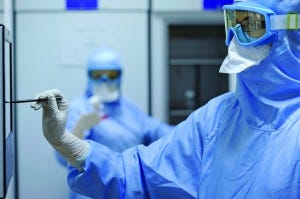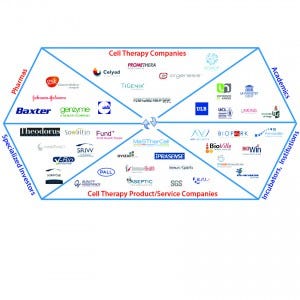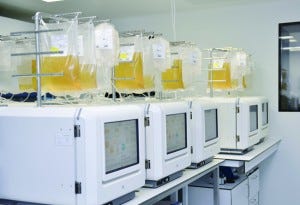Contract Manufacturing of Cell Therapies: A Conversation with MaSTherCell’s Eric Mathieu and Thibault Jonckheere
May 17, 2016

WWW.MASTHERCELL.COM
The work of developing advanced medical products is spreading around the globe, and with it comes specialized contract services. Far from a “one size fits all” approach to development, and with few platform technologies yet available, contract service providers in the advanced therapeutics space must focus on helping to move promising science into good manufacturing practice (GMP) environments, but with regulatory pathways and eventual harmonization still under development.
One company that formed to address the specific needs of cell therapy developers is MaSTherCell (based in Gosselies, Belgium), which was acquired in 2015 by Maryland-based Orgenesis Inc. I spoke with MaSTherCell’s Eric Mathieu (chief operating officer) and Thibault Jonckheere (chief business officer) about their reasons for this therapeutic focus.
BPI: Some contract providers choose to specialize in specific therapy types such as cell therapies, antibody–drug conjugates (ADCs), and biosimilars. Can you begin by introducing yourselves and your company?

Figure 1: These and other companies in the region support the Belgium biopharmaceutical “ecosystem”
Mathieu: I am in charge of operations at MaSTherCell. I joined the company in 2012 with experience at small- and mid-sized biotech companies, including working under GMPs. My background includes large-scale cell-culture production and development. I liked the challenge of starting a company from scratch. We focused from the start on cell therapy applications. GMP operations for cell therapies can be developed and conducted on a smaller scale than for other biopharmaceuticals. We also benefit from connections with established biopharmaceutical companies in this region (Figure 1). So it is interesting to be a new player in this field.
Jonckheere: I am in charge of business at MaSTherCell and come from a finance background, which allows me to bring in another (nonscientific) point of view. Since I joined in 2013, we have grown from 15 to more than 70 people and probably will be close to 100 by the end of this year. We have 600 m2 of GMP space and will double that by the end of the year. Currently we are working on phase 1–3 projects with a number of international companies. We are evolving within an emerging sector where cooperation is necessary to succeed. And this is what will continue to make us successful: bright and collaborative individuals pushing the boundaries of known treatments to help find cures for patients who have none today. And we hope we will soon be able to do it worldwide with facilities abroad.
BPI: What made you choose to specialize in cell therapies?
Mathieu: I like to make an analogy between regenerative medicine and the Internet sector, like IBM, Yahoo, and other original players. At one point they grew so much that they couldn’t easily innovate anymore. They had to buy and are buying new technologies to survive. In our sector it is somewhat similar: Large pharmaceutical companies are looking into regenerative medicine and deciding when and how it could become a part of their future. It is exciting and thrilling to be working with cell therapies because we can innovate at very high levels of quality. The first product that will cure a global, life-threatening disease is something that we want to work for and hope to see realized very soon.
BPI: Cell therapies require specific handling and flexibility in their manufacture. What are the key elements of ensuring that these requirements are met for every client?
Mathieu: One of the most important elements is people. We need the correct people that form a qualified team ensuring that all operations are conducted with the necessary attention to quality. Our organization also needs to maintain a certain level of flexibility toward each client’s specific product and requirements. Trust and mutual respect is probably what can make the difference between successful and nonsuccessful partnerships. It is also very important to be as close as possible to patients and clinical centers, maintaining good communication internally and externally with all involved groups.
Jonckheere: Regulation of advanced therapeutic medicinal products (ATMPs) is different from regulations for other biopharmaceuticals (see the “Advanced Therapies Classifications” box). Even people from large, established biotechnology companies with solid experience in GMPs will need retraining to specific quality systems and GMPs for cell therapies. They need to know more about cell biology, for example. We have a rich environment in Belgium that makes it easy to find skilled people, but it still takes three to six months to train them — and these are people who come to us with university degrees and cleanroom experience. Some cell therapy processes are still quite manual and specific. It is important that people know what they are doing and that we take the time to train them.
Mathieu: Our relationship with the authorities is also important because we are all learning, sponsors and regulators alike.

WWW.MASTHERCELL.COM
BPI: Would you discuss the production platforms and process development approaches you use?
Mathieu: Some companies are developing platforms, but those are not operational yet. Skills and expertise from people in scientific fields and classical biotechnology are needed to address manufacturing issues as completely as possible. Technology needs to be based on cell type, so there are a lot of different providers of equipment. Not all bioreactors will work with all cell types, for example. Also, today not a lot of bioreactors dedicated to cell products have been used in fully closed production systems (which could allow a company to decrease the environmental classification of the room to grade C or even grade D). This is not because the technology does not exist, but because not many people have found the correct way yet to combine these devices in meaningful production platforms.
So there is still quite a challenge to developing a robust industrial platform that could work with a number of different cell types. We still need to customize cell types or processes, such as Invetech does for its clients.
BPI: Do you help your clients prepare to automate their processes?
Jonckheere: Yes we do, together with specialized partners. But we think today it is more realistic to help them at earlier stages, creating processes that make sense to scale up later. More and more new companies understand the importance of that (and it was probably not that easy a few years back when all the technology was not yet available). But it is a shift in mindset for many start-ups. We focus first on demonstrating that we can reproduce their results to show we understand what they are doing and for everybody to feel comfortable. Then we suggest what improvements we can — maybe not based on our company experience, but from our staff members who have previous experience in areas such as viral vectors, vaccine development, and bioreactor design. So we try to bring our expertise to each process. This is a kind of translation of clients’ science into a GMP environment, helping them also conduct parallel process development activities.
The difficulty today is that process development can become linked to a technology provider. That can speed development early on, but it commits a cell therapy developer to using that technology in the future. By the time a product reaches phase 3, its sponsor may find that it is too late and too expensive to make major changes to the process. We want to help our clients avoid that by providing process development support from the beginning, taking into consideration aspects like yield, quality, logistics, assay development, COGS, production scale, and technology choices.
BPI: What key factors help ensure a successful transfer of a client’s project to your company?
Mathieu: Conceptually, technology transfer itself is not so different, really. We have to understand the clients’ processes and how to translate them into GMP conditions.
But when you look at it in more detail, cell therapy products have some specificities that make their tech transfer different. For example, finding GMP-grade and standardized raw materials is not that easy. Or demonstrating comparability when there is big potential patient variability is not so obvious either. So again, we have to listen to what our clients have developed and understand why; and then try to replicate it intelligently in our manufacturing and quality system.
Jonckheere: From a business perspective, we sign quality agreements with our clients to ensure a good understanding of our roles and responsibilities (and theirs) throughout a development process. This is a key element to define who will do what. But there are also immaterial considerations, subjective issues involving the attitude and spirit needed to deal with the complexity of a process. Some issues that may arise will be hard to control. It is more than just a process to execute; the cell biology makes doing so extremely difficult. For example, when you produce a virusbased product, in the end you can use sterile filtration to clean up errors made upstream. But you don’t have that safety net in cell therapy manufacturing. We share key metrics with our clients for process control. We may understand a process, but the client knows its product/cells better. The key to close partnerships with our clients is to maintain a direct line of communication between those teams.
BPI: Is your focus on autologous or allogeneic products?
Jonckheere: The market today shows that around 70% of cell therapy products in development are autologous and 30% are allogeneic. From a long-term perspective, my personal opinion is that only allogeneic products (for which we hope to be a major player) will be manufactured at a central facility. Autologous therapies will be produced at hospital sites directly. Hospitals already have cleanrooms for in vitro fertilization, for example.
Mathieu: But even if the work is done in hospitals, the goal is to decrease costs by closing systems to ensure that processes will be realistic and validatable. We are convinced that the way forward to allogeneic therapies is to have centralized facilities. Those also would enable companies to combine existing technologies and customize processes, encouraging innovation.
BPI: What other key technical issues do you encounter when working with cell therapy sponsors?
Mathieu: Because we are working with cells that will be injected into patients, in most cases we need to make them as quickly as possible. Cells can be frozen for up to three months, but normally a patient is waiting for them to be returned in five to seven days — which is a big challenge for us. To be able to do this, we (for example) developed a validated method for release (showing sterility) in seven days. We offer expertise in quality control. We ensure the safety of patients from contaminants and confirm product identity and purity. We offer the skills for developing a method that maintains its product attributes and function.
BPI: Do you develop assays?
Mathieu: In general we can perform 80–90% of in-process and release testing in house. For some products we can do it all, but some specific tests will still need to be outsourced to specialist companies here in Belgium. We always try to improve our flexibility by acquiring new equipment and in-sourcing tests when it makes sense to do so.
Regarding assay development and validation, we also have complementary teams in-house. Moving forward, and in parallel with assay development, there is also a great need to reduce costs of manufacturing — and eventually of final cell therapy products. To achieve that goal, biomanufacturers need to add value and expertise from other areas of the biotechnology industry and develop and manufacture products in parallel. For example, I think that it could be intelligent to use isolators to produce more products so that we can close off open phases of processes from contamination within a large class C room. Then we can continue with large-scale closed and automated bioreactors afterward.
Jonckheere: I have heard it said that although there are still challenges in the biology of cell therapy, the biggest hurdles lie in the underlying technologies and associated costs. Those problems can be addressed by introducing automated and closed systems, which ensure robustness, safety, and reproducibility. For that, our industry as a whole still needs to develop products and platforms to meet the needs of this emerging class of biotherapeutics.
Advanced Therapies Classification |
Companies can consult the European Medicines Agency (EMA) to determine whether a medicine they are developing is an advanced-therapy medicinal product (ATMP). The procedure allows them to receive confirmation that a medicine, which is based on genes, cells or tissues, meets the scientific criteria for defining an ATMP. EMA’s Committee for Advanced Therapies (CAT) delivers scientific recommendations on ATMP classification after consultation with the European Commission within 60 days after receipt of the request. |
The following useful documents can be accessed at www.ema.europa.eu/ema/index.jsp?curl=pages/regulation/general/general_content_000296.jsp:
|
S. Anne Montgomery is cofounder and editor in chief of BioProcess International, [email protected].
You May Also Like





